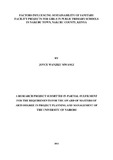| dc.contributor.author | Mwangi, Joyce W | |
| dc.date.accessioned | 2014-09-10T13:23:15Z | |
| dc.date.available | 2014-09-10T13:23:15Z | |
| dc.date.issued | 2014 | |
| dc.identifier.citation | Joyce Wanjiku Mwangi (2014). Factors influencing sustainability of sanitary facility projects for girls in public primary schools in nNakuru town, Nakuru County, Kenya. Masters of Arts Degree in Project Planning and Management | en_US |
| dc.identifier.uri | http://hdl.handle.net/11295/74289 | |
| dc.description.abstract | The study sought investigate the factors influencing the sustainability of sanitary facility
projects for girls in public primary schools in Nakuru Town Sub-County Nakuru County,
Kenya.A descriptive survey design was used. The study targeted the 59 public primary
schools in Nakuru town comprising of 1100 girls, 59 Head teachers and 271 teachers. Simple
random sampling was used to select the 18 headmasters, 80 teachers and 330 pupils. The
research was guided by the following objectives: To establish the extent to which availability
of funds influence sustainability of girls sanitary facilities in public primary schools; To
determine the extent to which government policy influence sustainability of sanitary facilities
for girls in public primary schools and to establish the extent to which awareness on
sanitation influence sustainability of sanitary facilities for girls in public primary schools of
Nakuru Town Sub-County Nakuru County, Kenya The Main research instruments used in
this study were questionnaires and interviews schedules. Piloting was done in two schools
which are not included in the sample for the Validity of the instrument which were
determined by checking the response of the respondents against the research objectives.
Reliability of the instruments was ensured by the split-half method. The data collected was
both qualitative and quantitative. Statistical methods were employed in analyzing quantitative
data where frequencies and proportions were used in interpreting the respondent‟s perception
of issues raised in the questionnaires so as to answer the research questions. The researcher
used tables in data presentation. The findings of the study indicated that sanitary facilities in
all sampled schools were highly inadequate in terms of state and numbers. This was majorly
as a result of lack of sustainability which was affected by lack of funds, sanitary knowledge
and implementation of a enacted government sanitary policy. The study also indicated that
Free Primary Education is a factor that has led to the inadequacy of sanitary facilities. The
study recommends that the Ministry of Education should conduct regular monitoring of the
cleaning and maintenance of sanitation facilities in public primary schools. Both students and
members of staff should be trained on proper use and maintenance of sanitary facilities. It
was also recommended that a separate budget is put aside by government and schools to cater
for this indispensable service in the schools. | en_US |
| dc.language.iso | en | en_US |
| dc.publisher | University of Nairobi | en_US |
| dc.title | Factors influencing sustainability of sanitary facility projects for girls in public primary schools in nNakuru town, Nakuru County, Kenya | en_US |
| dc.type | Thesis | en_US |
| dc.type.material | en_US | en_US |

